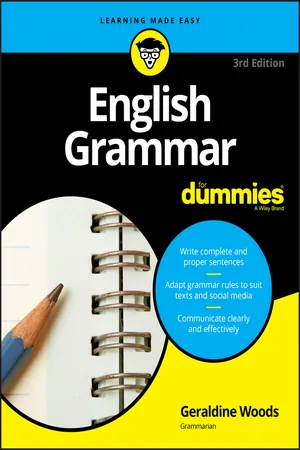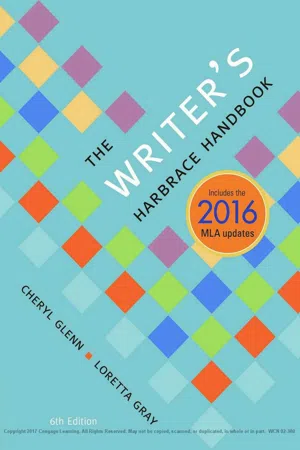Languages & Linguistics
Apostrophe
In linguistics, an apostrophe is a punctuation mark used to indicate possession or to show that letters have been omitted in a contraction. It is also used in some languages to indicate a specific grammatical function, such as marking the genitive case in English. The apostrophe is a versatile and important element in written language.
Written by Perlego with AI-assistance
4 Key excerpts on "Apostrophe"
- eBook - PDF
Linguistics for Everyone
An Introduction
- Kristin Denham, Anne Lobeck(Authors)
- 2012(Publication Date)
- Cengage Learning EMEA(Publisher)
454 • CHAPTER 13 Representing Language: The Written Word Sometimes we use punctuation to prevent misreading or mispro-nouncing of words. An example of this is words in which a prefix that attaches to a root morpheme might lead to mispronunciation: co-op , re-evaluate , re-examine . Usually a hyphen is used to sepa-rate the prefix from the root, though some editors or publishing companies use other techniques: The New Yorker magazine, for example, uses a diaeresis (¨) over the second vowel, indicating that two adjacent vowels are in separate syllables: coöp , reëvalu-ate ; elsewhere, it is written with no hyphen or diaeresis, letting the context suggest the appropriate word and pronunciation: coop , reevaluate . Though change in punctuation rules tends to be slower than other changes in our written system, some are in flux. For example, the use of Apostrophes is definitely in a state of transition, though their use has been quite varied since they began to be used in the seventeenth century. Apostrophes set off the -s morpheme in possessives: Alicia’s Bridal Shop We also commonly see, especially in signage: Alicias Bridal Shop Apostrophes are also commonly used to mark plurals in what is known as the “greengrocer’s Apostrophe” because it is used frequently on grocery store signs: plum’s $1.29/lb. Apostrophes are also commonly used to mark plural proper names (on a mailbox or in an address): The Jones’ The Talbot’s Using an Apostrophe to mark a plural is typically considered an error, and although such errors enjoy a lot of popular press time (the New York Times bestseller Eats, Shoots and Leaves is a screed of just such punctuation errors), most of them are founded on a certain amount of linguistic logic and are not just laziness. - Geraldine Woods(Author)
- 2023(Publication Date)
- For Dummies(Publisher)
Chapter 17 IN THIS CHAPTER » Showing ownership with Apostrophes » Shortening words and phrases with Apostrophes » Avoiding common Apostrophe errors 298 UNIT 5 Spelling, Punctuation, and Capitalization The Pen of My Aunt or My Aunt’s Pen? Using Apostrophes to Show Possession Most other languages are smarter than English. To show possession in French, for example, you say the pen of my aunt (la plume du ma tante) You can say the same thing in English, too, but English has added another option — the Apostrophe: my aunt’s pen Apostrophes may also show another kind of ownership — a relationship: Bob’s uncle The uncle doesn’t actually belong to Bob the way a book or a pen may. However, these two people are in an uncle–nephew relationship. The Apostrophe shows that the uncle belongs to Bob. Things or places can also be in an “ownership” role that’s expressed by an Apostrophe: the book’s cover Brazil’s coastline When you’re deciding whether you need an Apostrophe, consider whether the word of expresses what you’re trying to say. With the of method, you note the sharp claw of the crocodile = the crocodile’s sharp claw the peanut-stained trunk of the elephant = the elephant’s peanut-stained trunk and so on. The of test works even when no clear owner appears in the phrase. Such a situation arises mostly when you’re talking about time. Take a look at these phrases: one week’s house cleaning = one week of house cleaning a year’s lawn care = one year of lawn care Here’s the bottom line: When you’re talking about time, give your sentence the of test. If it passes, insert an Apostrophe. Think of an Apostrophe as a little hand holding on to something or someone. The “owner” — the person or thing that possesses — is the word with the Apostrophe and the letter s. CHAPTER 17 Little Hooks, Big Problems: Apostrophes 299 Ownership for singles No, I’m not talking about buying a home all by yourself, with your very own mortgage.- eBook - ePub
- Geraldine Woods(Author)
- 2017(Publication Date)
- For Dummies(Publisher)
Part 3Conventional Wisdom: Punctuation and Capitalization
IN THIS PART … Discover the conventions, or standards, of punctuation. Find out when and where to insert periods, commas, quotation marks, Apostrophes, and other punctuation so that your sentences mean what you want them to mean. Find out when to capitalize a word or an abbreviation. Examine how grammar adapts (or doesn’t) to electronic media so that your texts, tweets, posts, and presentations have the right effect on your readers.Passage contains an image Chapter 11
Punctuation Law That Should Be Repealed: Apostrophes
IN THIS CHAPTERShowing ownership with ApostrophesShortening words and phrases with ApostrophesAvoiding common Apostrophe errorsTaking a walk recently, I noticed an odd sign:GRANDMAS PUNCHInteresting, I thought. Grandmas punch whom? Their grandchildren? Surely not! People who refuse to look at one more photo of the adorable tykes? Possibly. I soon realized that the sign was in front of a bar. Ah, I thought. Grandma’s punch — a drink made from a family recipe. Then I heard a thud, as the Apostrophe rule bit the dust yet again.Apostrophes are curved punctuation marks that hang near certain letters, or, occasionally, numbers. For some reason, even educated people throw Apostrophes where they don’t belong and leave them out where they’re needed. So I favor repealing the Apostrophe rule. As New Yorkers say, “Enough already!” Until that happy day when Apostrophes disappear, you have to learn how to use them. In this chapter, I show you how Apostrophes indicate ownership and shorten words.The Pen of My Aunt or My Aunt’s Pen? Using Apostrophes to Show Possession
Most other languages are smarter than English. To show possession in French, for example, you say- the pen of my aunt (la plume du ma tante)
- the fine wines of that bar
- the letters of the lovers
- Cheryl Glenn, Loretta Gray(Authors)
- 2016(Publication Date)
- Cengage Learning EMEA(Publisher)
You can use them to show that someone owns something (my neighbor ’ s television), that someone has a specific relationship with someone else (my neighbor ’ s children), or that someone has produced or created something (my neighbor g g ’ s recipe) . Apostrophes are also used in contractions (can ’ t, don ’ t) and in a few plural forms (x ’ s and y ’ s) . This chapter will help you use Apostrophes to uni25A0 indicate ownership and other relationships ( 39a ), uni25A0 mark omissions of letters or numbers ( 39b ), and uni25A0 form certain plurals ( 39c ). 39a I NDICATING OWNERSHIP AND OTHER RELATIONSHIPS An Apostrophe, often followed by an s , signals the possessive case of nouns. (For information on case, see 26a(1) and 26b .) Possessive nouns are used to express a variety of meanings. Ownership Dyson ’ s sermon, the minister ’ s robe Origin Leakey ’ s research findings, the guide ’ s decision Human relationships Helen ’ s sister, the teacher ’ s students Possession of physical Mona Lisa ’ s smile, the s s team ’ s spirit s s or psychological traits Association between democracy ’ s struggles, tyranny ’ s abstractions and attributes influence Identification of dri ver i i ’ s license, bachelor ’ s degree documents and credentials Identification of St. John ’ s Cathedral, things named after people Rubik ’ s Cube Copyright 2017 Cengage Learning. All Rights Reserved. May not be copied, scanned, or duplicated, in whole or in part. WCN 02-300 714 P The Apostrophe (1) Forming the possessive of singular nouns, indefinite pronouns, acronyms, and abbreviations Add -’s to form the possessive case of most singular nouns, indefinite pronouns, acronyms (words formed by letters or initial word parts of phrases), and abbreviations. the instructor ’ s office [noun] Dickinson ’ s poems [noun] someone ’ s billfold [indefinite pronoun] sonar ’ s strength [an acronym of sound , navigation , ranging ] FAQ ’ s usefulness [an acronym for frequently asked question ] Luther Liggett Jr.
Index pages curate the most relevant extracts from our library of academic textbooks. They’ve been created using an in-house natural language model (NLM), each adding context and meaning to key research topics.



